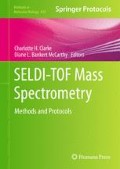Abstract
The mucosal surface of the female genital tract is the first site of contact for many sexually transmitted infections and serves as the first layer of defense. This layer has components of both the innate and adaptive immune systems to protect against infections. For these reasons, this fluid is a major focus of study to understand the pathogenesis of different infectious diseases. Novel tools are available to allow for the analysis of the components of this mucosal layer, including the area of proteomics. The emergence of proteomics has allowed for the development of many types of platforms for protein profiling, including gel-based technologies (2-dimensional differential in-gel electrophoresis) and mass spectrometry-based techniques. SELDI-TOF, a mass spectrometry-based platform coupled to on-chip chromatographic separation, has been developed as a high-throughput technique to profile complex protein samples. This chapter will outline detailed methods to profile cervical mucosal samples by SELDI-TOF and can serve as a guideline for other types of mucosal samples.
Access this chapter
Tax calculation will be finalised at checkout
Purchases are for personal use only
References
Valore, E.V., et al., Antimicrobial components of vaginal fluid. Am J Obstet Gynecol, 2002. 187(3): p. 561–8.
Venkataraman, N., et al., Cationic polypeptides are required for anti-HIV-1 activity of human vaginal fluid. J Immunol, 2005. 175(11): p. 7560–7.
Hein, M., et al., Antimicrobial factors in the cervical mucus plug. Am J Obstet Gynecol, 2002. 187(1): p. 137–44.
Horton, R.E., et al., Cervical HIV-Specific IgA in a Population of Commercial Sex Workers Correlates with Repeated Exposure But Not Resistance to HIV. AIDS Res Hum Retroviruses, 2008.
Burgener, A., et al., Identification of differentially expressed proteins in the cervical mucosa of HIV-1-resistant sex workers. J Proteome Res, 2008. 7(10): p. 4446–54.
Iqbal, S.M., et al., Elevated T cell counts and RANTES expression in the genital mucosa of HIV-1-resistant Kenyan commercial sex workers. J Infect Dis, 2005. 192(5): p. 728–38.
Kaul, R., et al., HIV-1-specific mucosal IgA in a cohort of HIV-1-resistant Kenyan sex workers. Aids, 1999. 13(1): p. 23–9.
Pereira, L., et al., Identification of novel protein biomarkers of preterm birth in human cervical-vaginal fluid. J Proteome Res, 2007. 6(4): p. 1269–76.
Gravett, M.G., et al., Proteomic analysis of cervical-vaginal fluid: identification of novel biomarkers for detection of intra-amniotic infection. J Proteome Res, 2007. 6(1): p. 89–96.
Bae, S.M., et al., Two-dimensional gel analysis of protein expression profile in squamous cervical cancer patients. Gynecol Oncol, 2005. 99(1): p. 26–35.
Iqbal, S.M., et al., Elevated elafin/trappin-2 in the female genital tract is associated with protection against HIV acquisition. Aids, 2009. 23(13): p. 1669–77.
Dasari, S., et al., Comprehensive proteomic analysis of human cervical-vaginal fluid. J Proteome Res, 2007. 6(4): p. 1258–68.
Thulasiraman, V., et al., Reduction of the concentration difference of proteins in biological liquids using a library of combinatorial ligands. Electrophoresis, 2005. 26(18): p. 3561–71.
Castagna, A., et al., Exploring the hidden human urinary proteome via ligand library beads. J Proteome Res, 2005. 4(6): p. 1917–30.
Sennels, L., et al., Proteomic Analysis of Human Blood Serum Using Peptide Library Beads. J Proteome Res, 2007.
Author information
Authors and Affiliations
Corresponding author
Editor information
Editors and Affiliations
Rights and permissions
Copyright information
© 2012 Springer Science+Business Media, LLC
About this protocol
Cite this protocol
Burgener, A. (2012). Profiling Cervical Lavage Fluid by SELDI-TOF Mass Spectrometry. In: Clarke, C., McCarthy, D. (eds) SELDI-TOF Mass Spectrometry. Methods in Molecular Biology, vol 818. Springer, New York, NY. https://doi.org/10.1007/978-1-61779-418-6_11
Download citation
DOI: https://doi.org/10.1007/978-1-61779-418-6_11
Published:
Publisher Name: Springer, New York, NY
Print ISBN: 978-1-61779-417-9
Online ISBN: 978-1-61779-418-6
eBook Packages: Springer Protocols

